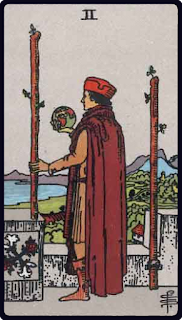
Representing balance; the number two represents the mathematical concept of parity, or evenness. For every action there is an equal and opposite reaction, for every Cause, there is an Effect, and for every state of being there is an inverted state. It is held in spiritual practice that nothing is given for free, there is always a price. This mirrors the law of Physics where energy cannot be created nor destroyed it can only be transferred from one form into another, and the nature of causality once more.
In the upright state the 2 of Wands draws our attention to the cost of our actions and the resources we employ in our creative endeavours. When setting out on a new creative endeavour it is easy to get lost in the sea of potential that swells with opportunity beneath us, we need to refine our goals with realistic objectives. This requires us to reflect on the resources we have available and draw from those.
In the inverted state the 2 of Wands represents an initial imbalance that will be rectified in time. The advice here is to be mindful of the initial investment being higher than we anticipated and the potential return seeming illusive at first. Faith in our own endeavours and the confidence needed to commit to them and pay the price needed is the key focus here.
In the Rider-Waite deck the 2 of Wands is depicted as a man standing on the battlement before parapets between two wands, one held in hand and one set to the side. The man holds in his hand a globe representing the World of the Major Arcana the potential prize if we succeed in our endeavours.
In the lower left you can see two white lilies and two red roses on a banner set against the parapet, these mirror the robes of the cardinals as depicted on the Hierophant they represent the duality and balance of fertility and opportunity in the red rose, and passion and sacrifice in the white lily.
In self-reflection the 2 of Wands asks us to consider whether we are spending too much time being creative and not following through with actions or if we are acting first without considering different approaches the emphasis here is finding a balance between our vision and our attempts to make that vision a reality. It is easy to get lost in the detail and to convince ourselves we are not ready to act without first gaining greater knowledge but this mentality can often serve more as a hindrance than an attempt to nurture caution.
Learning a language for instance require practice not only a theoretical understanding, you will never become fluent without first practicing what you have already learned. To seek theoretical fluency before putting that theory into practice will actively obstruct your objective.
Ask yourself “Have I thought this through?” or indeed “Am I overthinking?” and try to find a balance between learning through prediction and reflection.

No comments:
Post a Comment
All comments are moderated before they are published. If you want your comment to remain private please state that clearly.